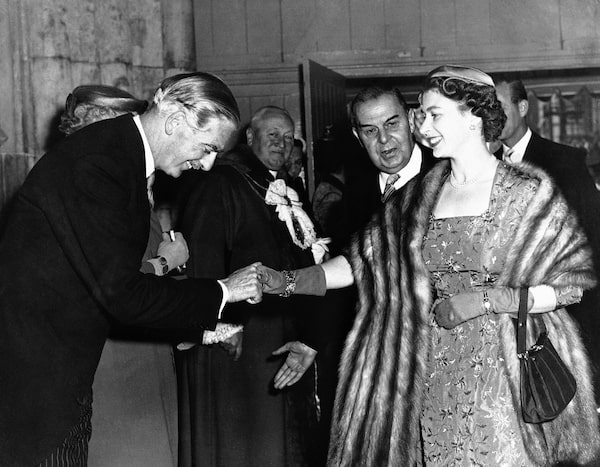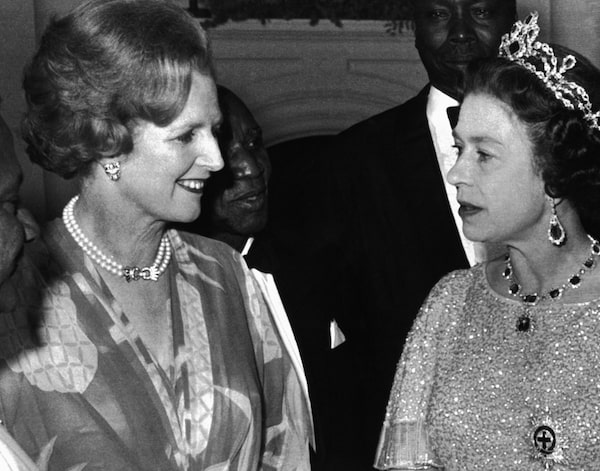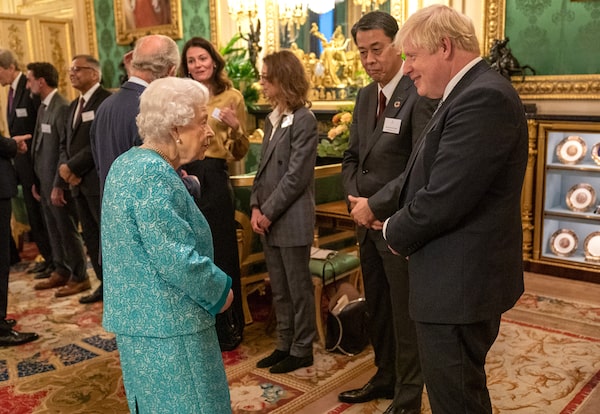
Britain's Prime Minister Anthony Eden, left, fresh from his victory over the Labor Party opposition in the British "frogman" incident, smiles and bows as he welcomes Queen Elizabeth II upon her arrival at London's Guildhall on May 15, 1956.The Associated Press
“Get that dog out of my house!” In 1973, Queen Elizabeth II was stoically entertaining Zaire’s dictator, Mobutu Sese Seko, at Buckingham Palace during his state visit to Britain. But when she discovered his wife had smuggled her lapdog into the country and palace, in flagrant violation of strict quarantine rules, she was visibly upset.
As royal biographer Robert Hardman wrote in Queen of the World, the offending dog was hastily removed to a quarantine facility and, as a precaution, the Queen’s beloved corgis were taken to Windsor Castle, leaving all parties to continue with the diplomatic visit, albeit with a frostier tone. Beyond that, we know next to nothing of Elizabeth’s thoughts on Mobutu’s regime – or on virtually any of the polarizing leaders and world-changing events of her 70-year reign.

Winston Churchill speaks at the opening of the International Youth Centre at Chigwell, Essex, alongside Princess Elizabeth, who performed the opening ceremony on July 12, 1951.Central Press/Getty Images
What is perhaps most surprising about the modern Elizabethan era, particularly to those who know more about the Queen from the Netflix drama The Crown than from actual Crown scholars, is how little is understood about her political role. Most documents regarding her views and communications are kept behind locked doors in archives across her realms, protected by privacy laws and freedom-of-information exemptions.
And they will stay hidden: A 2010 British act decreed all documents would remain secret until at least five years after the death of the monarch – an edict that will now apply to King Charles III, as well. The backlog is vast; some documents from the earliest times of Elizabeth’s reign, when the Korean War was still raging and Winston Churchill was prime minister, will be at least 75 years old before they are released.
That means there are potentially a dizzying array of political scandals waiting to be discovered in which the Queen played a role, however tangential, since everything undertaken by state actors – governments, diplomats, the military – is done in the name of the Crown. Some acts of the Queen’s reign include successive Canadian governments promulgating the residential school system; Britain’s actions in Africa both before and after decolonialization, including supporting the Nigerian government as it violently and systematically repressed and killed Biafrans seeking independence; the Windrush scandal, when post-war migrants from the Caribbean were wrongly identified by British authorities as illegal immigrants, denied services and rights and, in some cases, detained and deported; and how the monarch responded to calls that she officially apologize on behalf of the Crown for its role in the slave trade.
For a woman known as Reader No. 1 – because of the red leather boxes stuffed with official documents that she read on a daily basis for seven decades – many questions about her conduct remain unanswered: How much did the Queen know about those actions, decisions and issues? Though bounded by the limits of a constitutional monarch, did she agree, object or acquiesce?

Britain's Queen Elizabeth II talks with British Prime Minister Margaret Thatcher in Lusaka, Zambia, on Aug. 1, 1979.The Associated Press
The image built up since 1952 is of a dutiful Queen, whose inner calm and deliberately bland public persona emphasized her political neutrality. “Most of her [public] communications have very little or no political content at all. And that has been a source of her success in that she is not regarded as political and therefore she has the power to bind people from all political backgrounds as a unifying figure, a symbolic figure,” says Anne Twomey, a professor of constitutional law at the University of Sydney in Australia, who wrote the authoritative book The Veiled Sceptre: Reserve Powers of Heads of State in Westminster Systems.
Yet, she was a political actor, because as head of state, the duties undertaken by the Queen were inherently political. “It comes down to what you mean as politics,” says Philippe Lagassé, an expert on the Crown and an associate professor at Carleton University in Ottawa. “If you mean partisan politics, then I see why people would chafe. But if we mean participation in government in some way, shape or form, then she is a political actor by her own actions and what she represents.”
Certainly, Elizabeth was not as overtly political as many of her predecessors. “When you compare her to her grandfather’s reaction to Irish Home Rule, it’s like night and day,” Lagassé says. “So it also shifts with the times and expectations. And this is why she was political. She was a good barometer of where the constitution has been, where it’s headed and where it is going.”
Because of that public air of neutrality – she never sat for an interview or strayed from speeches that had been approved by governments – any deviation was guaranteed heavy scrutiny. In 2014, on the eve of the Scottish independence referendum, she made headlines by telling a well-wisher, “I hope people will think very carefully about the future.” Critics pounced, convinced she was urging voters to reject independence. The furor was so intense that Buckingham Palace released a statement stressing her impartiality.

Queen Elizabeth II meets with Economic Summit leaders (from left) French President François Mitterrand, Japanese Prime Minister Yasuhiro Nakasone, British Prime Minister Margaret Thatcher, U.S. President Ronald Reagan, Chancelor Helmut Kohl of West Germany and Italian Prime Minister Bettino Craxi, at Buckingham Palace on Sept. 6, 1984.DOMINIQUE FAGET/AFP/Getty Images
After the referendum was defeated, then-prime minister David Cameron revealed that the Queen “purred” when informed of the vote, adding, “I’ve never heard someone so happy.” Criticism was swift – but much of it was aimed at Cameron breaking a confidence rather than the Queen’s reaction. Even Scottish nationalist leader Alex Salmond wasn’t impressed with Cameron, snapping that it was a shame the prime minister hadn’t “learned basic civility on not gossiping about what Her Majesty the Queen thinks or doesn’t think.”
That Cameron revealed his side of a phone call with the Queen was a rarity. Those interactions with the monarch are confidential – the weekly audiences are held without aides – and leaders have only spoken of their relationship with the Queen by using the most anodyne quotes. “He thought her advice often quite wise,” Harold Wilson’s press secretary told author Ben Pimlott. The prime minister, who came from a middle-class family, unlike her previous PMs, looked forward to his weekly meetings with the Queen, though he had to do his homework lest she catch him out on a topic. “She was one of the few people, outside his own entourage, he was able to deal with on a regular basis without treating them as rivals or calculating their motives,” Pimlott wrote.

Prime Minister David Cameron and Queen Elizabeth II, ahead of a commemoration ceremony at Magna Carta memorial at Runnymede in Surrey, on June 15, 2015.Steve Parsons/The Associated Press
Twomey has researched one instance in which the Queen exercised overt political power. It was in 1987, when she initially supported Fiji’s governor general against Col. Sitiveni Rabuka after his military coup attempt. She only withdrew her support when, after a second coup, the governor general decided the nation needed to change its constitution to favour indigenous Fijians over Indo-Fijians, and wanted the Queen to amend the constitution unilaterally. “At that point, Buckingham Palace completely changed its tune,” says Twomey. The governor general was pressured to resign; in fact, the Queen’s private secretary wrote the resignation letter on his behalf. “They put out an announcement that, upon his resignation, the Queen ceased to be Queen of Fiji,” says Twomey. “It’s the only time I know where the Queen herself has terminated her role as Queen of a realm, without any ministerial advice.”
Given her involvement in international affairs, Lagassé thinks it’s not difficult to assume she was also involved in domestic British politics, albeit subtly. “The fact that we have to plumb the depths shows how different she has been to, say, an Edward VIII or even Victoria and other monarchs who came before her who were much more overt,” he says. “So even if we have what we think are clear instances of involvement in politics, she created a monarchy that is very much above the day-to-day partisan fray.”
That’s part of the reason her behind-the-scenes influence so interests both Crown experts. “The great success of Elizabeth II as monarch was to keep her considerable exercise of soft power out of the public view so that it was not threatened by public scrutiny,” wrote Twomey in an academic paper that compared Elizabeth to her female predecessor, Queen Victoria.

Britain's Queen Elizabeth II greets British Prime Minister Boris Johnson at a reception for international business and investment leaders to mark the Global Investment Summit, on Oct. 19, 2021, at Windsor Castle.ARTHUR EDWARDS/Getty Images
Where the Queen was most actively involved in issues was before they became public. “The Queen’s power and influence happened first in her regular meetings with the prime minister, where things were flagged to her before they became publicly recorded,” says Twomey. “She would see things in the planning stage so she would be able to raise and influence these things, not only with the prime minister but with other ministers.”
But rather than objecting directly, says the Crown scholar, “it’s a matter of raising an eyebrow and saying, ‘Are you sure this is appropriate?’” Sometimes politicians could miss the signals. In 1965, Postmaster-General Tony Benn tried to remove the Queen’s head from British stamps (Britain is the only country that does not need its name on a stamp if it features the monarch’s head). Though a face-to-face meeting left him with the impression that the Queen accepted his plan, he soon realized she was not happy at all. Eventually, he was persuaded to abandon the idea, wrote Pimlott in his regal biography.
The Queen could and did exercise influence in her constitutional role of monarch, says Twomey. “And that is protected deliberately by the British government through a whole range of things – by convention and by laws.” For instance, The Guardian has dug into the National Archives to create a list of more than 1,000 bills that were vetted by the Queen and Charles before being introduced in Parliament, under a rule that their consent was needed if anything affected their rights and privileges as royals or impacted, for instance, their private estates. As of 2021, the newspaper had found four draft laws in which Buckingham Palace lobbied for changes. Still, Lagassé isn’t perturbed by the so-called Queen’s consent (now King’s consent) rule, saying, “Fundamentally what we’re talking about is the palace’s lawyers doing what a lawyer would do for anybody, which is identify areas that affect their rights and try and push things in directions that protect their client. That would be non-controversial if it were anybody but the Queen.”

Queen Elizabeth II poses with G7 leaders at Buckingham Palace in London, on July 16, 1991. From left, U.S. President George Bush (seated), Italian Prime Minister Giulio Andreotti, Japan's Prime Minister Toshiki Kaifu, the Queen (seated), British Prime Minister John Major, France's President Francois Mitterrand (seated), Canada's Prime Minister Brian Mulroney, European Commission President Jacques Delors, German Chancellor Helmut Kohl (seated) and Dutch Prime Minister Ruud Lubbers.Lionel Cironneau/The Associated Press
Queen Elizabeth with Prime Minister Brian Mulroney, during her visit to Toronto, on Oct. 1, 1984.Thomas Slukovenyi/The Globe and Mail
In June, former Canadian prime minister Brian Mulroney recounted some of the Queen’s involvement in the Commonwealth’s fight against apartheid. In 1985, he told the Royal Commonwealth Society of Toronto, she “personally asked me to work with other leaders to prevent a major and, some thought, imminent split within the group” over imposing sanctions on the apartheid regime in South Africa. The organization was deadlocked, with Britain’s Margaret Thatcher vehemently opposed. The following year, on the eve of a mini Commonwealth summit in London, the Queen invited the summit’s participants to a “working dinner” at Buckingham Palace, without spouses or aides. “There was no doubt that Her Majesty sided with the Commonwealth,” Mulroney told royal biographer Sally Bedell Smith. “But she couldn’t speak out. You had to understand the nuances and body language.” The private dinner helped them reach a compromise: rather than striving for unanimity, the leaders agreed to disagree about imposing sanctions.
Sometimes, speculation about the Queen’s role in a scandal can’t match reality. For years, historians have theorized how deeply the Queen and Buckingham Palace were involved in the decision by Australia’s governor general to dismiss prime minister Gough Whitlam in 1975. In 2020, an Australian court ordered that the “palace letters” be released. They showed that the governor general acted alone, writing to the palace that “it was better for Her Majesty not to know in advance.”
That didn’t stop the conspiracy theorists from continuing to blame the Queen. Twomey doesn’t buy it. “There was never a sane reason as to why the palace would encourage the governor general to dismiss him,” she says. “If anything, the palace has always encouraged caution and to try to stay out of politics as best they can.”
Except in that Fiji situation. Of all the events of the Queen’s reign that will remain locked away for years to come, that’s the one Twomey is most curious about. “If anywhere the Queen was very active from a political point of view, it was in relation to that crisis in Fiji,” says the scholar, who plans to ask the Queen’s private secretary whether he’ll finally talk about those tumultuous events now that she’s gone.
It could be well into the reign of her son, or even her grandson, before a more complete story of Elizabeth II’s time as monarch is written. “We won’t know for quite a long time, even after the Queen’s death, what her role was. And even then, we won’t have the full scope, because an awful lot of it would have been done orally,” Twomey says. “So the role of the Queen politically is probably going to remain unresolved, possibly forever.”
Our Morning Update and Evening Update newsletters are written by Globe editors, giving you a concise summary of the day’s most important headlines. Sign up today.